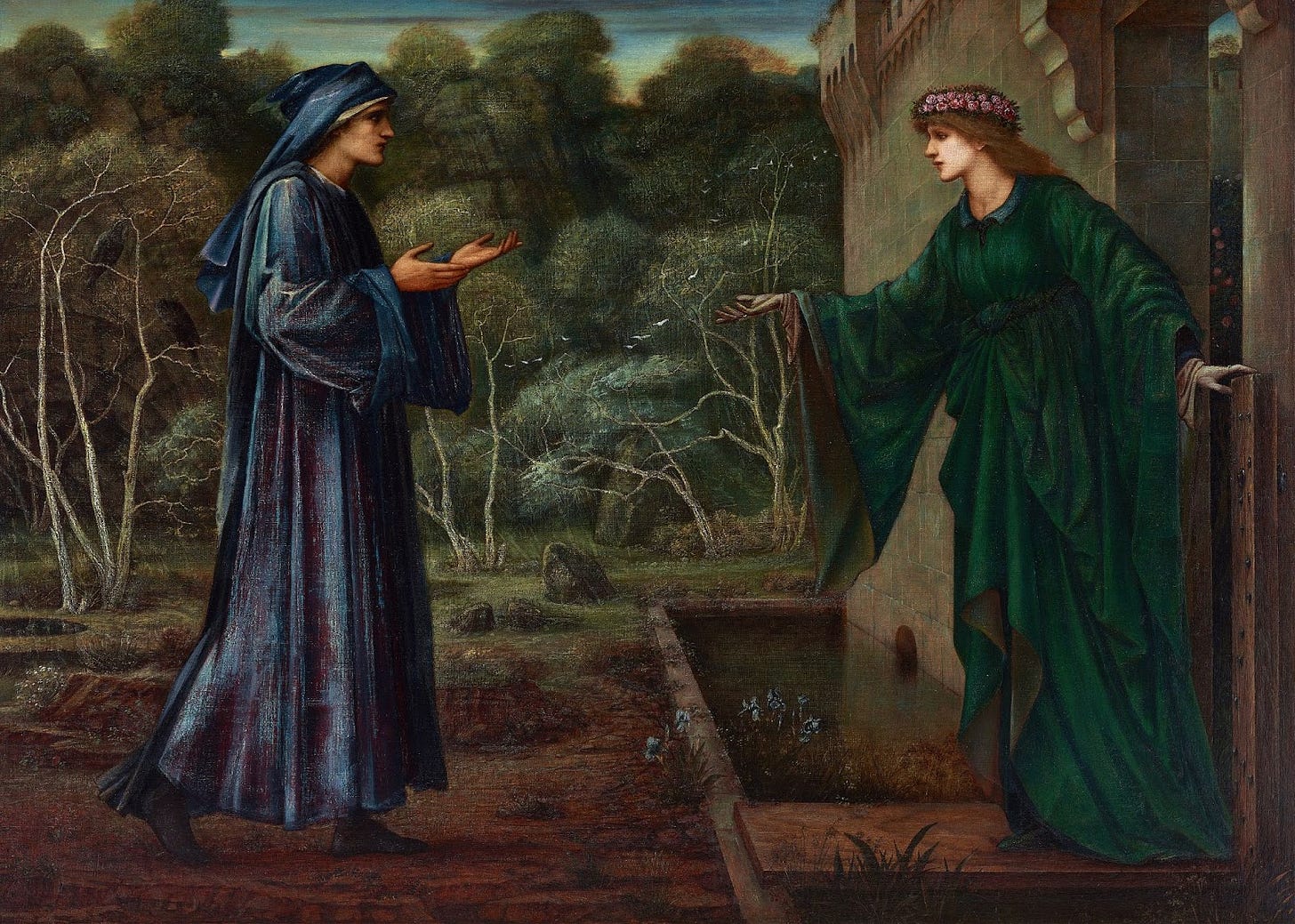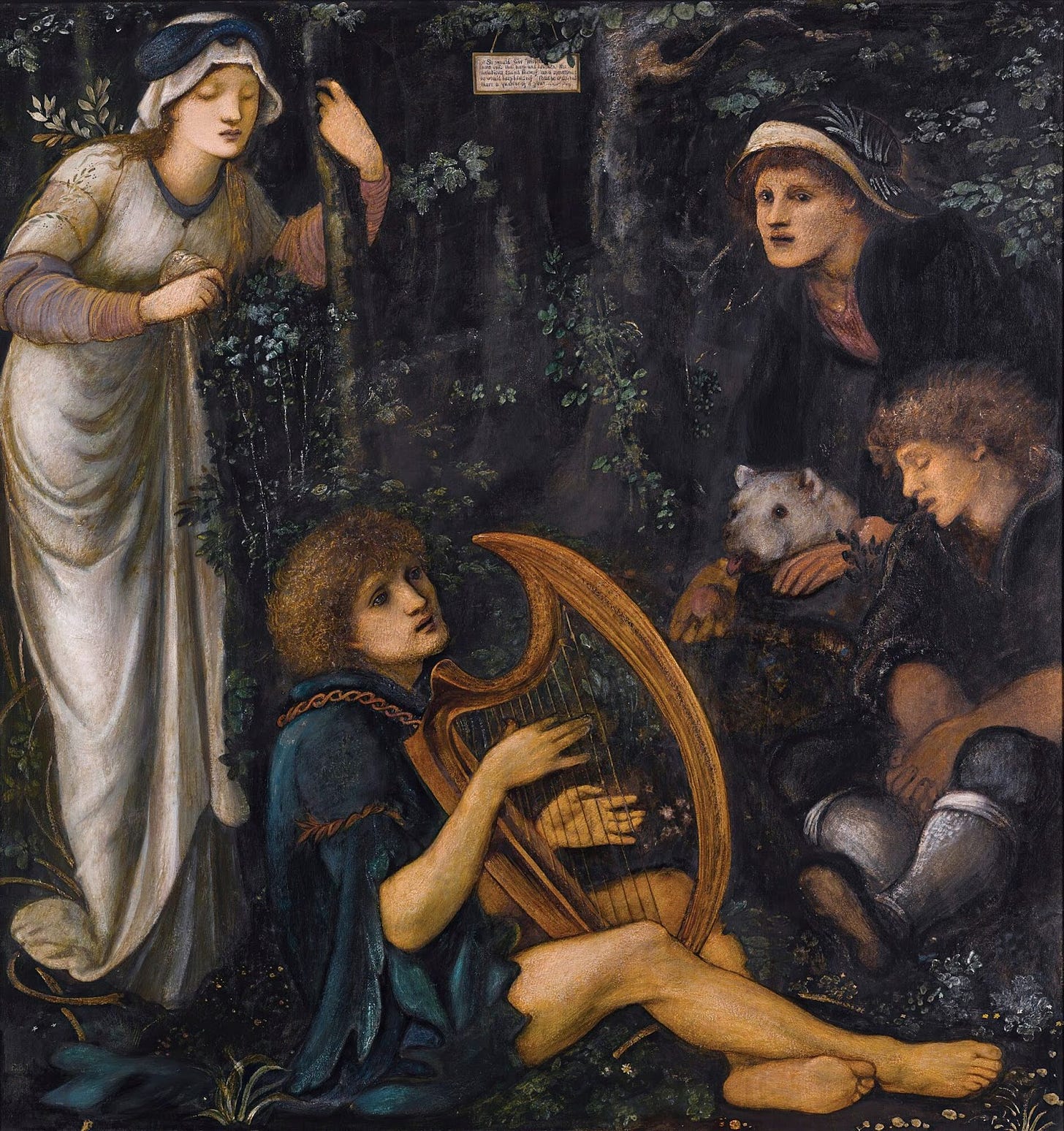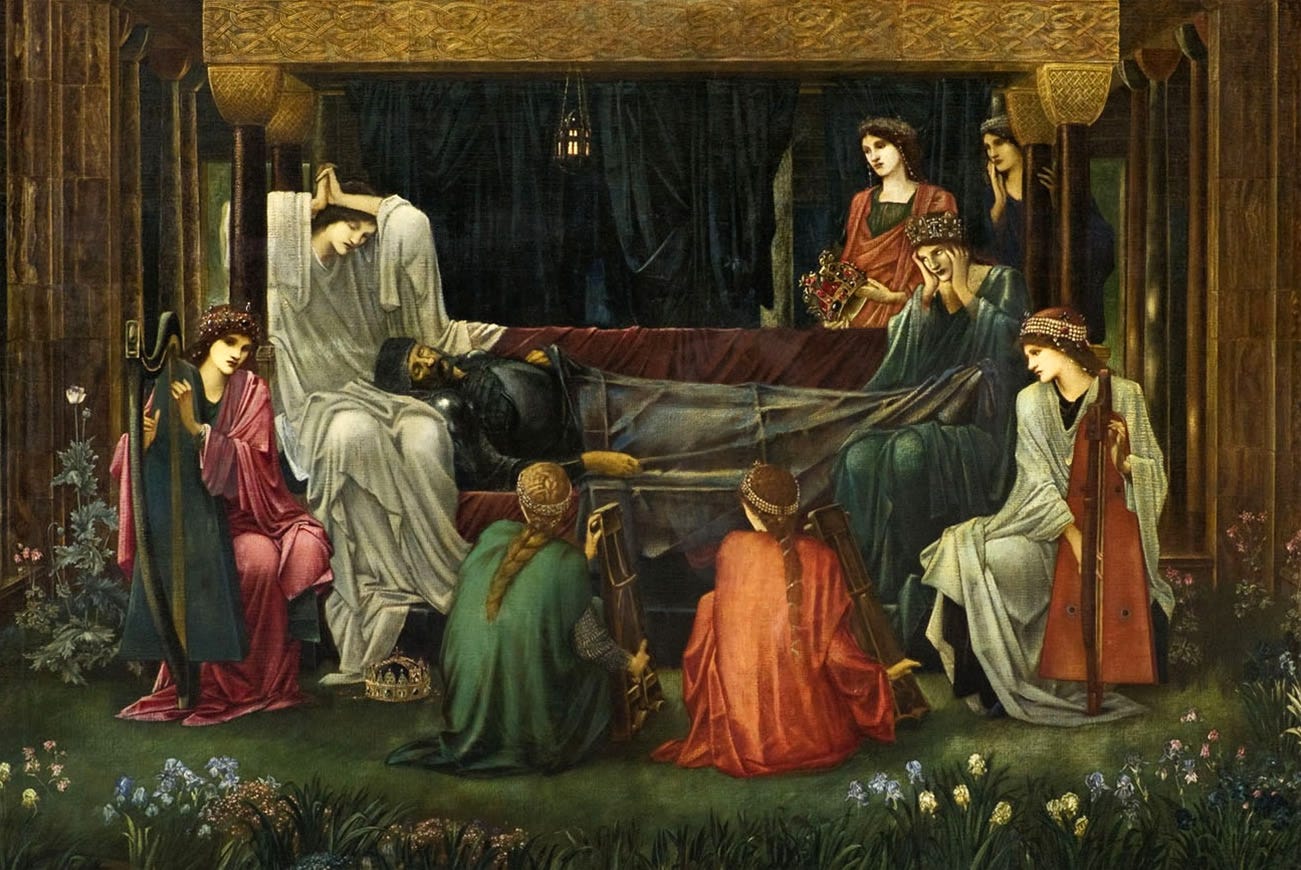The case for Middle English
It’s not just The Canterbury Tales
For some reason, Old English gets most of the love among people interested in the history of the English language.
Maybe it’s because Old English is the most distant stage of the language from Modern English, and, as such, it preserves ancient characteristics such as an elaborate system of word endings much more like Latin than the English of today.
Or perhaps it’s because Old English can boast of some of the best poetry in the history of the English language, including the peerless Beowulf.
But I want to make the case that the period between Old English and Modern English is just as interesting: Middle English.
Middle English is the name given to the period in the history of the English language, roughly between AD 1100–1450. It is (again, roughly) bookended by two major events which left a mark on linguistic history: the Norman Conquest of England in 1066 and the introduction of the printing press to England in 1476.
The Norman Conquest, in which William of Normandy (aka the Conqueror) took advantage of a dispute over succession to the English throne to invade and claim it for himself, brought an end to the Anglo-Saxon period in the history of England and the Old English period in the history of English.
Prior to the Norman Conquest, England, and the various petty kingdoms which preceded the unified English monarchy, was ruled by royal houses (mostly) of English origin.1
During the Anglo-Saxon period, the primary language of England through all strata of society was Old English, although Latin played an important role in the Church. The Norman Conquest changed that: in Normandy, the language spoken was a dialect of Old French.
When William took the throne in England, he initiated a large-scale replacement of the Anglo-Saxon aristocracy, as well as the positions of leadership in the Church. As a result, the country became largely trilingual: English was the language of the common people, French was the language of the aristocracy, and Latin remained where it was as the language of the Church.
Because English was relegated largely to the lower orders of society, the vibrant tradition of English-language literature which had existed during the Anglo-Saxon period came largely to an end. Largely, but not entirely.
We do have some English works from the early years after the Norman Conquest, including Layamon’s Brut (written around 1200), a semi-historical account of early Britain and, somewhat infamously, the Orrmulum (late 12th century), a collection of homilies, but it’s nothing like the literary explosion of the late 10th and early 11th centuries, immediately before the conquest.
Gradually, however, the English language regained its prestige, as the ties of the new English nobility to France weakened, both through their long stay in England and England’s gradual loss of territory in France over the course of the Hundred Years’ War (1337–1453).
This had an effect on the life of the upper classes: in the year 1362, for example, English replaced French for use in Parliament and the courts, which had earlier used French and Latin.
It was around this same time, in the fourteenth century, that a new rebirth of English literature began, and it produced some gems. I’ll talk more about them shortly.
But first, I want to give you a sense of what Middle English was like as a language, and why it is, in my opinion, the weirdest and maybe the most fun phase of English.
You're reading The Dead Language Society. I'm Colin Gorrie, linguist, ancient language teacher, and your guide through the history of the English language and its relatives.
Subscribe for a free issue every Wednesday, or upgrade to support my mission of bringing historical linguistics out of the ivory tower and receive two extra Saturday deep-dives per month.
If you upgrade, you’ll also be able to join our ongoing Beowulf Book Club and watch our discussion of the first 400 lines right away. Our next meeting is Thursday, August 14, 3:30–5:00pm Eastern.
What Middle English was like
Because Middle English was so distant from the halls of power for most of its history, it was far less subject to the homogenizing influences of top-down standards.
This means that, much more than during the other phases of English, Middle English appears to us like a collection of related dialects. And within that collection, there is a lot of diversity.
This diversity was almost certainly there in the Old English period, and the Modern English period too, but the writing largely didn’t (and doesn’t) reflect it.
But in the Middle English period, people wrote a lot more like how they spoke, which means we have access to that diversity for Middle English that we don’t have for Old or Modern English.
But this very feature of Middle English makes it slightly challenging to talk about, because there really isn’t one version of Middle English: there are several. Usually, when people talk about Middle English in the context of literature, they mean the dialect used by Geoffrey Chaucer (c. 1343–1400), which is a fairly late, London dialect of Middle English.
When we look at Chaucer’s Middle English, it’s not so far removed from Modern English that we can’t make heads or tails of it. In fact, this version of Middle English is so close that it doesn’t take too much interpretation to see how hilarious Chaucer could be:
Men may dyuyne, and glosen vp & doun
But wel I woot expres, with outen lye
God bad vs, for to wexe and multiplye
That gentil text kan I wel vnderstonde
Eek wel I woot he seyde þat myn housbonde
Sholde lete, fader and moder and take to me
But of no nombre, mencioun made he
Of Bigamye, or of Octogamye
Why sholde men thanne speke of it vileynye?
‘People can conjecture and interpret any way they like
But I know well plainly and without a lie,
God asked us to grow and multiply.
That noble text I can understand well,
I also know well he said that my husband
Should leave his father and mother and take to me.
But he made no mention of number,
Of marrying two, or of eight.
So why should people speak of ill of it?’
(Wife of Bath’s Prologue 27–35, Hengwrt MS)
If you listened to the audio above, you may have remarked that Chaucer is a lot easier to read than to listen to for a speaker of Modern English. This is because the spelling system of English hasn’t changed too much since Chaucer’s day, but the pronunciation has changed a lot.
But compare Chaucer’s late 14th-century London dialect with this text, written in the West Midlands in the early 13th century:
Aȝein alle temptatiuns, ant nomeliche aȝein fleschliche, saluen beoð ant bote under Godes grace: halie meditatiuns, inwarde ant meadlese ant angoisuse bonen, hardi bileaue, redunge, veasten, wecchen, ant licomliche swinkes, oþres froure forte speoke toward i þe ilke stunde þet hire stont stronger.
‘Against all temptations, and especially against carnal (temptations), there are cures and remedies under God’s grace: holy meditations, inward and persistent and anguished prayers, strong belief, reading, fasting, vigils, and bodily toils, the consolation of another person to speak to at the very moment that she is having a hard time.’ (Ancrene Wisse)2
The Ancrene Wisse ‘Anchoresses’ Guide’ was a monastic rule for anchoresses, women who withdrew from the world to lead a life of prayer.
Even though this is prose rather than poetry, it’s much more difficult to read from the perspective of a Modern English speaker than Chaucer’s verse was.
Many words and constructions in the text, in fact, hearken back to Old English. Compared to Chaucer’s Middle English, this is roughly 150 years older and from a different part of England. And yet both are, from a chronological perspective, Middle English.
Despite all this diversity, there are still things that different forms of Middle English have in common.
One is the wearing down of the system of endings that Old English used to show the function of words in the sentence. Instead of showing who is doing what to whom using different word endings, as Old English did, Middle English works much more like Modern English, and expresses who is doing what to whom using word order.
Another constant through the various dialects of Middle English is the introduction of words from Old Norse and French, although the influence of each of these languages varies depending on the dialect and the time period. Norse influence is strongest in the dialects of the east and north of England, a legacy of the Danelaw, a period of Danish settlement and rule in those regions.
And, in general, French influence on English became stronger as the period went on. Ironically, the presence of French words in English increased as the use of French by the higher classes as a spoken language decreased.
But as English was adopted by the upper classes, it was an English filled with French loanwords. The use of a “fancy” form of English, one full of French, served the function once served by speaking French: marking the social distinction between the upper and lower classes.
But beyond these large-scale trends, the diversity in Middle English is so great that every new text you read presents you with something new and interesting.
So now that I’ve dangled the prospect of the beautiful vistas of Middle English literature before you, what is there to read?
Three poems to start your exploration
Like Caesar’s Gaul, Middle English literature can be divided into three parts, or three genres that authors kept returning to throughout the period.
The first group is made up of religious texts, such as devotional works, saints’ lives, and mystical writings. The second group is courtly literature, works that celebrate the ideals of chivalry, and feature knights, ladies, and navigating complex codes of etiquette while facing temptation. Finally, there is the ever-popular Matter of Britain, or the Arthurian genre, which tells the story of King Arthur and his knights.
There is some overlap between these genres: religious themes appear in courtly and Arthurian works, and works of courtly literature often feature characters from the Arthurian cycle.
I imagine some ears have perked up at one or more of these genres, and, if so, you’re in luck: you can read most Middle English works without extensive linguistic training. All you need is a good edition of the text with annotations. Let’s look at a few choice texts, and I’ll show you where you can read them, and why I think you should.
The best place to start with religious works is Pearl, a late 14th-century allegorical poem written in the Northwest Midlands dialect. It is an extraordinarily intricate poem, both in its structure and in its meaning: it uses the image of a lost pearl to explore the topic of loss and the fleeting nature of life on earth and to explain Christian doctrine. Here’s a sample:
Perle, plesaunte to prynces paye
To clanly clos in golde so clere,
Oute of Oryent, I hardyly saye,
Ne proved I never her precios pere.
So rounde, so reken in uche araye,
So smal, so smothe her sydes were,
Queresoever I jugged gemmes gaye
I sette hyr sengeley in synglure.
Allas, I leste hyr in on erbere;
Thurgh gresse to grounde hit fro me yot.
I dewyne, fordolked of luf-daungere
Of that pryvy perle withouten spot.
(Pearl 1–12)
Here’s J. R. R. Tolkien’s translation of those same lines:
Pearl of delight that a prince doth please
To grace in gold enclosed so clear,
I vow that from over orient seas
Never proved I any in price her peer.
So round, so radiant ranged by these,
So fine, so smooth did her sides appear
That ever in judging gems that please
Her only alone I deemed as dear.
Alas! I lost her in garden near:
Through grass to the ground from me it shot;
I pine now oppressed by love-wound drear
For that pearl, mine own, without a spot.
If you liked that sample, you can read Pearl for yourself. Use an edition with ample explanatory notes and commentary, such as the one at the Middle English Text Society website.
As for courtly poetry, start with Sir Gawain and the Green Knight, a poem written by the same author as Pearl. Although it is technically also an Arthurian poem, the main action in the poem doesn’t relate to the events of the wider Arthurian cycle. Instead, it tells the story of the hero Sir Gawain as he faces the difficulty of adhering to the strict rules of chivalry in situations of temptation. Here’s a sample:
Þe fyrst word þat he warp, ‘Wher is,’ he sayd,
‘Þe gouernour of þis gyng? Gladly I wolde
Se þat segg in syʒt, and with himself speke raysoun.’
To knyʒtez he kest his yʒe,3
And reled hym vp and doun;
He stemmed, and con studie
Quo walt þer most renoun.
‘The first word that he said was “Where is
the leader of this company? Gladly I would
see that man in person, and speak with him reasonably.
He cast his eye to the knights,
And rolled it up and down,
He stopped and began to try
Who there had most renown.’ (lines 224–231, my translation)
There isn’t a great digital edition like the ones from the Middle English Text Society for Sir Gawain and the Green Knight. But you can use Tolkien’s edition of the Middle English text along with his Modern English translation to get a similar experience. Alternatively, if you’d like a digital edition (albeit one without many notes), the University of Toronto’s Representative Poetry Online has the original alongside a translation.
Finally, if you’d like to start reading Arthurian literature in Middle English, begin with The Alliterative Morte Arthure.4 This is a poem of just over 4000 lines, written in the East Midlands dialect around the year 1400, which tells the story of King Arthur himself, or at least, the end of it. I probably don’t have to sell you on why that’s interesting. Instead, I’ll go right to a sample:
Me thought I was in a wood, willed mine one
That I ne wiste no way whider that I sholde,
For wolves and wild swine and wicked bestes
Walked in that wastern wathes to seek,
There lions full lothly licked their tuskes
All for lapping of blood of my lele knightes!
‘It seemed to me that I was in a wood, wandering alone
where I didn’t know which way to go,
for wolves and wild swine and wicked beasts,
walked in that wasteland seeking prey.
There lions very hatefully licked their teeth
All for the lapping of the blood of my loyal knights!’
(lines 3249–3245, my translation)
Here’s the edition from the Middle English Text Society if you want to keep reading.
Those are the three main genres of Middle English literary works. But there is one exception to this way of thinking about the period, and it’s a big one: the most famous Middle English author, Geoffrey Chaucer.
Chaucer, despite his great fame, is actually the least typical Middle English author. Although Chaucer drew on the three earlier medieval genres I discussed here, he transformed them in a way that changed English literature forever, and set the course for the new types of literature that would emerge in the Renaissance.
So, ironically, the one Middle English author that most people read is the one who is least representative of the period. Nevertheless, you should absolutely read him despite (or because of) that.
But I’ll save my advice about getting started with Chaucer for another day. In the meantime, you have more than enough to keep you busy for a while. So go forth, take up your sword (annotated edition), and embark on your quest to explore the world of Middle English.
With two periods of interruption in the 11th century in the persons of the Danish Sweyn Forkbeard (reigned 1013–1014) and his son Cnut the Great (reigned 1016–1035) and his sons Harold I (reigned 1035–1040) and Harthacnut (1040–1042), although Harold I was English on his mom’s side.
The letters ‘þ’ and ‘ð’ are pronounced ‘th’. More on that here. As for ‘ȝ,’ it’s a long story: here, it’s pronounced ‘y.’
Here, the ‘ȝ’ in syȝt ‘sight’ and knyȝtez ‘knights’ is pronounced like the ‘h’ in huge or the ‘ch’ in German ich. But the ‘ȝ’ in yʒe ‘eye’ is pronounced like ‘y.’
The metre of the Alliterative Morte Arthure is very similar to that of Old English alliterative verse.





Wonderful stuff! As an Icelander I'm always glad to see þ and ð in oðer þings 😁😁
I’m liking this new knowledge about old language!